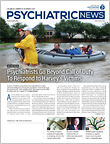Sandro Galea, M.D., M.P.H., Dr.P.H., a professor and head of the School of Public Health at Boston University, spends a lot of his time these days thinking about methylation because he wants to expand our view of how the vicissitudes of the world around us affect our bodies, our brains, and even our genes.
“I think we have been focusing on a narrow set of variables and experiences,” said Galea in an interview. “In the fullness of time, we’ll see that the dichotomy between physical and mental health is an artifact.”
Mental health symptoms can now be seen to have much in common with more traditionally constructed physical health phenotypes, which probably suggests common biological mechanisms. For example, he said, “I think the biological pathways that we understand as being immune system disorders are similar to pathways that go awry when we’re dealing with some phenotypes that we have typically attributed to psychological sources,” he said.
The last several decades have focused on the human genome as a blueprint for health, but that is giving way to a far more nuanced perspective involving methylation or demethylation of DNA, said Galea. “It’s the intersection with experiences, starting even in preconception and running through the intrapartum period, early childhood, and then throughout life, that ultimately inscribe themselves on whatever genetic blueprint one has.”
Trauma is yet another, and all-too-common, mechanism.
“The future in this field lies in how outside experiences get under the skin, and trauma is a valuable model of that,” he said. “We know violence and trauma happen to nearly everyone. The only thing we don’t know is when they’re going to happen.”
Six million people worldwide die from injury each year, many of them teens or young adults, compared with 4.5 million people who die from HIV, tuberculosis, and malaria combined. The consequences of trauma may last a lifetime as well, a fact at odds with the views of the public and the media, which have short attention spans, he said.
“Even if our work focuses on biology, genetics, transcription factors, or epigenetic modification, we’re not going to understand the burden of traumatic events unless we can combine that inner world with an understanding of the world outside the skin,” said Galea.
His own work in Liberia, 20 years after that country’s civil war ended in 1990, demonstrated how the aftereffects of trauma linger beyond the event itself.
“PTSD still maps the [geographic] path of conflict,” he said. “Some of that is linked to experience in the war, but mostly it’s due to the breakdown of the social order and civic structure that led eventually to more violence and unemployment.”
The “long tail of traumatic event exposure” also can reach across generations, he said. A child’s experience with trauma will be worse if his mother had posttraumatic symptoms, likely due to some combination of epigenetic factors, biochemical imprinting, and behavioral imitation.
Personal history matters, too. Trauma-exposed U.S. soldiers who experienced childhood adversity and previous lifetime stressors or traumatic events were more likely to have increasing depression symptoms and chronic dysfunction over time than those with less prior adversity.
Without question, genetics remains a powerful determinant of health. But the molecular biological modifications of the genetic code, frequently stimulated by external experience, demand closer attention now, he said. “And I think as we move in this direction, we’ll see that there is a lot more room to understand how the exogenous affects your health when one realizes that we’re not dealing with an intractable code.”
Thinking about the response to external stress or to its prevention demands an equally complex vision, one that loops back to classic public health paradigms. For one thing, the conventional idea of resilience is too simplistic.
“We’re not looking for a magic molecule or a magic gene,” he said. “Our search for resilience is not a search for something static. We’re looking for the complex interplay between unchangeable, fundamental biology and dynamic physiology on the one hand and rapidly changing context on the other.”
If the population experience of trauma is expressed as a bell curve, treatment can trim the curve on the right, but that would miss the full spectrum of biology and context.
“If our goal is to make populations healthier, we must intercept trauma before it strikes,” said Galea. “Better to shift the curve to the left to prevent trauma in the first place by combining our understanding of inside the skin with outside the skin.”
Transformative population-level interventions include affordable housing, food security, a basic livable wage, and universal early childhood education.
“There is good evidence for all of these, and they are not all that radical,” he said. “They do fall outside the usual medical paradigm, but they have important, positive effects on the prevalence of trauma.” ■
“Population Health in an Era of Rising Income Inequality: USA, 1980-2015” can be accessed
here.

